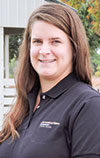Now, there isn’t much we as producers can do to control the weather or how hot our cows get because of fermentation. But there are a few management practices you can do to make it easier for your cattle to stay cool.
First is water. Easy access to water is critical for cows exposed to very high temperatures. In temperatures up to 70ºF, cattle may drink more than 2 gallons per 100 pounds of bodyweight, meaning a 1,300-pound cow will drink 26 gallons of water in a day. That may not seem like a lot, but when the temperatures reaches over 95ºF, that water consumption will double to 4 gallons per 100 pounds bodyweight, meaning each cow is consuming 50-plus gallons of water per day.
Also pay attention to water quality. Ponds and ditch access are great because cattle can also go into the water to cool down, but spending too much time there blocks other cows from drinking and decreases the water quality, causing some cows to lower consumption when they need it most. Providing enough trough space and clean water will allow all cattle to access water during these hot temperatures.
Another way cattle keep cool is from the natural breeze. Cattle will actually prefer a breeze over shade because flies will typically congregate in areas where cattle stand under shade, making the cows irritable. Cows also crowd under shade, reducing ventilation they may get from the breeze. Regions that get more breeze are usually ridges or high areas of a pasture; keeping these areas open for cattle to congregate will allow them to spread out and benefit from the breeze.
Something not a lot of us think about with heat-stressed cattle is salt and minerals. Because of their increased water consumption, cattle are also excreting salt and minerals in very high amounts. Cattle need to replace these nutrients quickly to maintain a good immune system. You can do so by placing mineral feeders close to areas they water.
If possible, avoid handling, transporting or processing cattle during hot weather. If you must handle cattle, do so in the early morning hours to reduce stress. Working cattle in the evening is another option, but keep in mind it can take up to six hours after temperatures drop for an animal to bring their body temperature to a comfortable level. ![]()

-
Carmen Willmore
- Extension Educator
- University of Idaho Extension – Lincoln County
- Email Carmen Willmore








